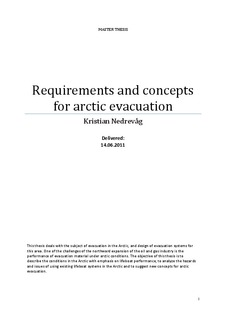| dc.description.abstract | Operation of manned oil and gas installations in arctic locations is complicated and presents new challenges. One of the challenges is to maintain the safety of the crew, by obtaining adequate lifeboat systems for crew evacuation. This master thesis focuses on different methods for meeting this challenge.
The weather and climate conditions in the Arctic are very different from the conditions we find in more southern oceans. Extreme temperatures, winds caused by polar lows, icing and sea ice presents new and difficult challenges which is demanding for the operation of lifeboats.
Hazard identification analyses of two types are performed to identify potential hazards of operating existing lifeboats in arctic conditions. These identify the following hazards as the most critical:
Freezing of moving davit componentsRisk of floating pieces of ice occurring in the launching zone for free fall lifeboatsClose pack ice present at the time of evacuationOpen drift ice or close pack ice present during the initial operational phaseSea spray icing on the lifeboat at seaOpen drift ice or close pack ice present in the operational phase
Based on the hazard identification analyses, a specification of requirements for arctic lifeboats is established. This specification is intended to supplement, and not replace, the existing regulations and requirements which apply to lifeboats.
Based on the specification, alternatives for modification of existing lifeboats are suggested and discussed. The modification alternatives include modifications of launching equipment, hull strengthening and propulsion equipment. However, full compliance with the specification is not believed to be achievable by modifications.
Three different concepts for arctic survival crafts are outlined, each intended for a specific set of ice conditions. Concept one is an arctic free fall lifeboat, intended to be launched by free fall in the icefree summer season, and launched by a more conventional method in the ice season. The lifeboat is designed to be able to operate in higher ice concentrations than existing lifeboats are capable of. Concept two is an arctic conventional lifeboat, intended to be launched in the same way as existing conventional lifeboats. It is designed to operate in very high ice concentrations, by use of Archimedes screws. Concept three is an arctic survival vehicle, designed to operate in continuous ice and very high ice concentrations. Propulsion is provided by twin pair of tracks.
In the final part of the thesis, the Arctic Free Fall Lifeboat is developed further. Dimensions, capacities, hull design and features for arctic operation are described. An improved launching arrangement is also described, capable of operating in two different modes depending on the ice concentrations in the area.
The thesis concludes that existing lifeboats can be modified to achieve better performance and safety in arctic conditions, but the potential for improvement is limited. To achieve high performance and a high level of safety, arctic lifeboats must be designed and built for this purpose. | nb_NO |
